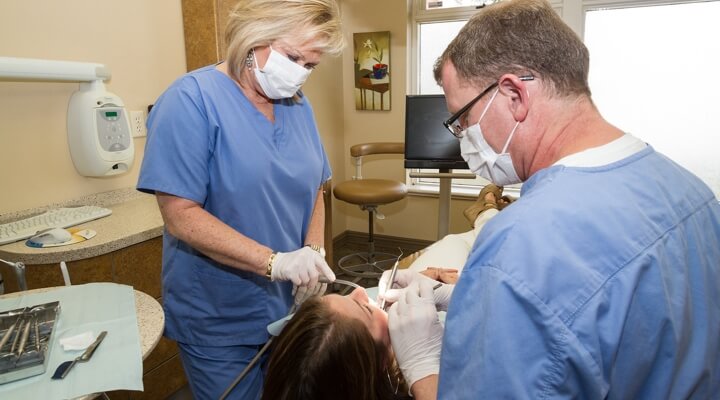Periodontics

A periodontal exam should always be part of your regular dental check-up. A periodontal probe (small dental instrument) is gently used to measure the space between the tooth and the gums. If your gums are healthy, the space will be three millimeters or less and the gums not prone to bleeding. The periodontal probe helps indicate if pockets are deeper than three millimeters. Pockets deeper than three millimeters can indicate the existence of periodontal disease.
Your dentist or hygienist will use pocket depths, amount of bleeding, inflammation, tooth mobility, etc., to make a diagnosis that will fall into one of the categories below:
Gingivitis
Gingivitis can be a precursor to periodontal disease. Gums irritated by plaque and its by-products become tender, inflamed, and may be likely to bleed.
Periodontitis
If plaque is not removed it will harden into calculus (tartar). As calculus builds up, the gums may begin to recede from the teeth. Deeper pockets then form between the gums and bone and become filled with bacteria. The gums become increasingly irritated, inflamed, and bleed easily. This may be accompanied by slight to moderate bone loss..
Advanced Periodontitis
If periodontitis becomes advanced, the teeth lose more support as the bone and periodontal ligament continue to be destroyed. Without treatment, teeth in the affected area will become very loose and may be lost. The gums may shrink away from the teeth or may just become inflamed.
Treatment
Early stages – If the disease is caught in the early stages of gingivitis, and no damage has been done, one to two regular cleanings will be recommended and you will be given instructions on improving your daily oral hygiene habits and having regular dental cleanings.
More advanced stages– A special periodontal cleaning called scaling and root planing (deep cleaning) will be recommended. Usually this is done one quadrant of the mouth at a time while the area is numb. In this procedure, tartar, plaque, and toxins are removed from above and below the gum line (scaling) and rough spots on root surfaces are made smooth (planing). This procedure helps gum tissue to heal and pockets to shrink. Medications, special medicated mouth rinses, and an electric tooth brush may be recommended to help control infection and healing.
If the pockets do not heal after scaling and root planning, periodontal surgery may be needed to reduce pocket depths, making teeth easier to clean. Your dentist may also recommend that you see a Periodontist (specialist of the gums and supporting bone).
